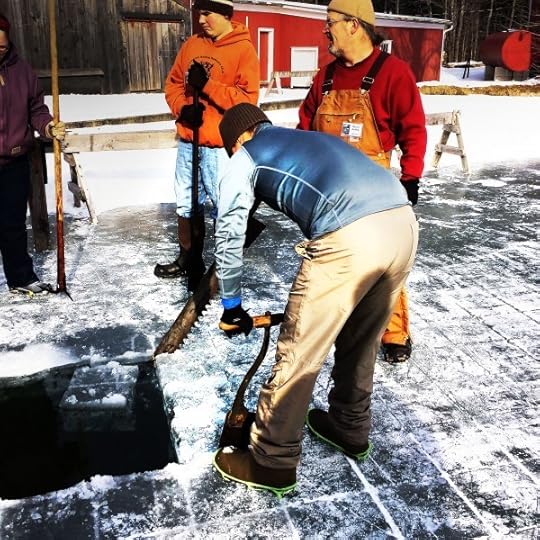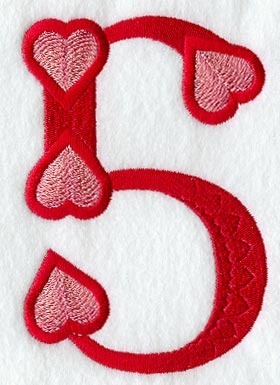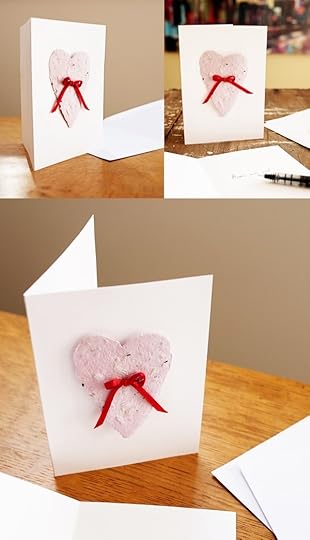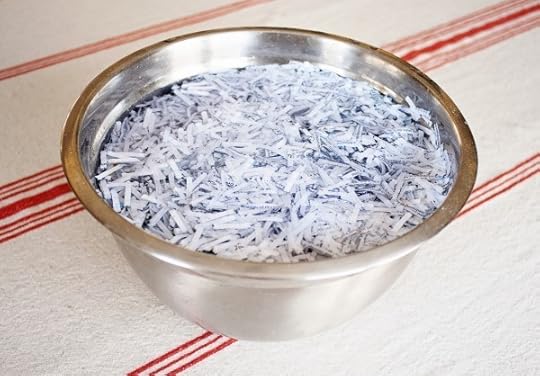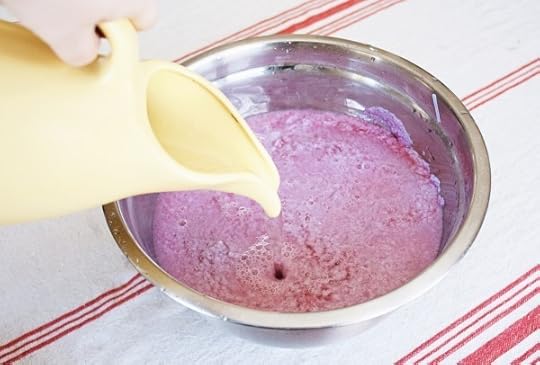Josh Kilmer-Purcell's Blog, page 56
February 15, 2014
The Original Big Dig
The Erie Canal
In an earlier blog, we discussed the Cherry Valley Turnpike, so critical to the 19th-century history of the Sharon Springs region. Railroad lines, developed later that century, also shaped the demographics and economy of upstate New York, as we touched upon in another blog. Also in the 19th century, the Erie Canal, connecting the Hudson River, north of Albany, and Buffalo, north of Lake Erie – at its closest to Sharon Springs, about 10 miles to the north in Montgomery County – had great impact, helping open up lands to settlement and economic development west of the Appalachian Mountains.
Native Americans used the waterways of the Northeast for travel and trade long before non-Natives came to the Americas. In the colonial period, Europeans and Euro-Americans used flat-bottomed, shallow-draft bateaux to haul cargo. But, unlike the Native-designed birch-bark canoes, bateaux were not suitable for long portages, and plans were conceived to alter the waterways. A canal between the Hudson River and Lake Ontario was proposed in 1768, but never received backing. In 1792, the Western Inland Lock and Navigation Company built small wooden channels with locks around the falls and rapids of the Mohawk River, but because of maintenance problems, the operation soon folded.
What was first known as the Great Western Canal – and eventually the Erie Canal – was proposed in 1808, resulting in a number of surveys. The survey of the chosen 363-mile route between the Hudson River and Lake Erie was completed in 1816. Federal funds fell through, but the New York State legislature, with the support of DeWitt Clinton, the mayor of New York as well as the New York Canal Commissioner – and, as of 1817, governor of the state – backed the project. To defray the costs of construction, tolls would be charged for use of the canal. But many were skeptical, and the project came to be referred to as “Clinton’s Folly” or “Clinton’s Ditch.”
Construction began on July 4th, 1817. The first segment undertaken was a relatively flat 94-mile-stretch between Rome, NY, and the Hudson River. The Canal Commission negotiated with some landowners – especially farmers – to do the construction where the route traversed their property. As time went on, more and more laborers from the cities were hired, many of them Irish, German, and English immigrants. Working with hand tools and horse-drawn equipment, they carved a 40-foot wide, 4-foot deep canal – lined with dirt in some stretches and with stones in others – as well as a 10-foot wide towpath for the teams of horse and mules to pull barges. Conditions were miserable. Diseases, such as malaria, typhoid fever, and pneumonia (called “DeWitt’s Diseases,” again after Clinton) were a problem, especially in swampy regions. Accidents also resulted from the use of gun powder and blasting powder to break through rock. An unknown number of fatalities occurred, victims laid to rest along the route in unmarked graves.
The entire route from Albany to Buffalo had a 568-foot rise in elevation, and 83 stone-walled locks were engineered. Moreover, 18 overhead aqueducts were built where streams crossed the canal.
With completion of the canal in October 1825, boats – both barges and passenger packet boats – could navigate all the way from the Atlantic Ocean around New York City to the Great Lakes. To celebrate the accomplishment, Governor Clinton and other officials made the trip on the Seneca Chief, starting the day the canal opened, October 26th, and arriving in New York City on November 4th. Many communities along the way held celebrations to welcome the dignitaries, one of the largest gatherings taking place in Albany
In 1836-62, the canal was widened to 70 feet and deepened to 7 feet. The number of locks in the “Enlarged Erie” was reduced to 72. As many as 250 boats a day passed through a given lock, and at its peak an estimated 50,000 people depended on the Erie Canal for their income. Entire families lived on some of the boats. “Hoggees” walked alongside the horse and mule teams. “Towpath walkers” inspected the canal walls for leaks. Workmen traveled in “hurry-up boats” to those places where repairs were needed. As shipbuilding evolved, steam-powered boats became the norm, and the towpaths evolved into popular walking paths for the public.
In 1903-18, the Erie Canal was rebuilt, making it 120 to 200 feet wide and 12 to 14 feet deep, with concrete waterways and electronic controls.
It was also reorganized as part of the growing New York State Barge Canal System, including the Oswego Canal, the Cayuga-Seneca Canal, and the Champlain Canal.
Use of the various canals declined with increasing rail lines in the late 19th century, and modern roads to carry trucks and automobiles in the 20th century. The opening of the Saint Lawrence Seaway to the north in 1959, allowing ships to travel between the Atlantic Ocean and the Great Lakes, furthered the decline of commercial traffic along New York’s canals. The system, renamed the New York State Canal System in 1992, still carries some cargo and is popular for recreational boating.
In addition to various cruises, there are many sites and museums to visit along what is designated as the Erie Canalway National Heritage Corridor, which includes branch canals as well as the original Erie Canal, a total of 524 miles of waterways. The Old Erie Canal State Historic Park comprises a 36-mile trail from Rome, NY, where ground was first broken in 1817, to the Butternut Creek Aqueduct in Dewitt to the west. The Erie Canal Village in Rome has three museums in addition to buildings and businesses relating to the time period. The Erie Canal Museum in Syracuse is located in a restored 19th-century weighlock building. We’d also recommend visiting Lock 17 in Little Falls, only about 30 miles to the northwest of Sharon Springs, and watch the operation of what for a time was the world’s highest single lift lock, raising boats over 40 feet. And at Schoharie Crossing in Fort Hunter, about the same distance from Sharon Springs but to the northeast, the Schoharie Aqueduct – an Erie Canal National Historic Landmark – is the only remaining location where all three phases of New York’s canals can be viewed at once.
If you would like a source to help keep the fascinating history of the Sharon Springs region straight, you can order our eBook The Sharon Springs Timeline for $4.99 at the link (click here), or from Amazon.com or Kobo.com. Here’s our Authors’ Note from the book:
The Sharon Springs Timeline: A Microcosm of American History with Dates Relating to a Remarkable Village and Neighboring Regions, from the 16th Century to Modern Times is a study aid intended to help in ongoing research. It provides an overview as well as a compendium of easily referenced dates. It is also meant to inspire new studies, giving a glimpse of the area’s rich history to both residents and visitors. The dates of course are secondary to the events listed under them, but they give some order to the disorder of history. The images displayed – as found on early postcards – affirm the theme of the Timeline as a guidebook to a region, with an emphasis on history.
The Village of Sharon Springs is remarkable in its widely varied degree of economic ebb and flow and diversity of people. Understanding its complex history – and that of surrounding regions – helps one understand the history of an entire nation.
The Timeline is divided into five categories: (1) Settlement and Demarcation (2) Politics and Warfare (3) Technology and Transportation (4) Historic Businesses and Buildings (5) Education, Arts, and Entertainment. The events listed under these subject areas range in scope – from world news to village news – serving as a reminder that the world is made up of small communities and their individuals. There are many more fascinating events and enterprises relevant to the region not included. This is a sampling, a starting point.
All the years mentioned in the Timeline are shown in boldface. Cross-references at the end of entries provide historical threads, directing the reader forward in time.
While working on this outline of history, we met many fascinating people who have given us guidance and we extend a warm thanks to all of them. We were also fortunate in having access to invaluable written sources. The dates of the publication of some of these are given in the final section of the Timeline, as are the dates of the founding of some historical societies, museums, and libraries preserving the region’s history.
Learn more about “the ditch that salt built” click here
2014′s Goat Births
Kidding has begun in earnest! (Is that sentence an oxymoron?)
We’ll be updating this page almost daily to record every single new birth at Beekman 1802 Farm this year. Kidding season lasts from February till May, with a few breaks in between for Farmer John to catch his breath.
For those who may not be familiar with how John expertly manages his herd, he selects two or three bucks to breed most of the 120+ does from September to November. Then the does get a nice winter maternity break when they can all relax and enjoy their pregnancy in the warm comfort of the barn, without being milked. Although this means we can’t produce our famous Blaak Cheese or other milk products during the winter months, this period of collective rest improves their health, (and John’s too!) as well as the quality of the milk.
Then, beginning in mid-February, all heck breaks loose. We expect over 200 kids this year. When the kids begin arriving, not only do they need to be bottle fed, but the mothers begin milking again as well. This is Farmer John’s busiest season. He also rises in the middle of the (short) night to check on any births in progress.
Of course we can’t keep all of the kids. Farmer John is selective in his choices, deciding which female kids to keep based on whose mothers produced the most milk the previous year (as well as other factors.) The males and remaining females get sold, generally to other farmers and those looking for pets. If you’re interested in purchasing a kid from Farmer John, send us an email at Beekman1802@Beekman1802.com and we’ll forward your message to him.
Enjoy the photos of this year’s kids! (You’ll notice that the names of the female kids all begin with the first initial of their mother’s name. That’s to help John keep track of lineage.)


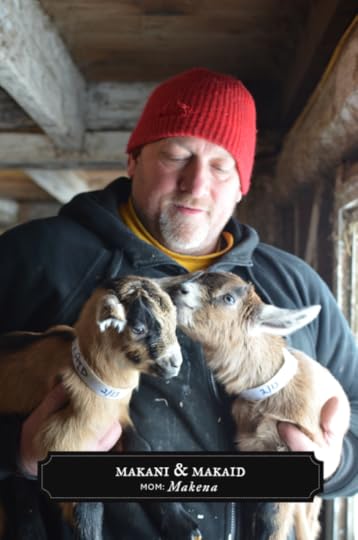
<
>
February 13, 2014
Gartending to the Heart
Klaus just returned from a lovely trip to Vermont. He’s very fortunate to have been invited to the Northeast Kingdom and make new friends along the way. One of these friends, Todd Hardie is a bee keeper and maker of a most marvelous group of spirit medicinals. The raw honey that goes into his marvelous vodka, gin and elderberry cordial speak clearly of his passion for healing.
Vermont is rife with family farms. It’s not easy to make a living here in this often harsh environment. Get away from the ski towns that live off the tourists and discover a place that is off the usual path. I suggest doing this by following food and drink.
Klaus thinks that if you want to win the heart of a beautiful woman you must ply her with his newest loves, Vermont maple syrup and Vermont cheeses. Of course Klaus tells me that there has to be some liquor in there too. That’s where Todd Hardie comes in. Klaus is smitten by the flavors exemplified in each sip of Barr Hill Gin and Barr Hill Vodka. You see, Klaus discovered that these spirits are actually made from something that comes from bees! In Germany and Caledonia bees were raised for their honey. This honey, when fermented and distilled is powerful medicine used by apothecaries for hundreds of years. Now in the modern age, this distillation of honey goes into Barr Hill products. It’s remarkable and delicious.
Vermont Maple Syrup is richly scented and deeply aromatic. It’s memorable from the minute it touches your tongue and the finish goes on and on.
I was fortunate to visit Jasper Hill and received a private tour of the cheese caves. Jasper Hill, if you are not familiar makes highly expressive cheeses that speak clearly of Vermont.
Klaus had to stay inside because of the FDA regulations about cleanliness. He would have had to receive a total sterilization. He wasn’t happy about that, so he took a nap instead.
Klaus just told me that with Valentine’s Day coming up, he thought a considerate gift of raw honey would be in order. Raw honey does many things, Klaus tells me. But I think what Klaus is really trying to say is that for Valentine’s day to be truly special there must be a drink to make basic conversation a bit easier. Why is that Klaus? He’s not talking right now. He’s napping. The trip up to Vermont was hard on the little guy. All those new faces to remember and all those kisses he received. Klaus if you are just discovering him is quite famous.
In keeping with the theme of Valentine’s Day and Klaus having only a ceramic heart, love doesn’t come easily to him. Oh sure, all the ladies love Klaus but I’m not sure that he can love them back. He certainly has enough admirers. Right Klaus?
As long as he has a drink nearby all is well.
Valentine’s Day is the perfect day to have more than one, within reason of course. Why is that? Because my (Klaus’s) drinks are quite intoxicating! He’s interested in flavor and aromatics from always-fresh herbs, even in the winter!
Klaus brought some gorgeous fresh sage the other day at the Asian market. He explained to me that this sage, when carefully lit on fire makes the most beguiling smoke. He went on to explain that if you have burning sage and you hold your Boston Shaker over the top, you can capture this smoke within the shaker! Klaus went on to explain that Barr Hill Vodka, (distilled from raw honey, of course) when mixed with freshly squeezed grapefruit juice, and smoked sage “smoke” makes for a colorful and potent cocktail. One nearly guaranteed to make “conversation” easier later in the evening.
The smoked sage and grapefruit juice act as a foil to the more potent, honey-tinged notes of this exceptional vodka. Those who have be following my writing know that I normally don’t write about vodka, so it has to be pretty darned exceptional for me to even take note. Barr Hill is that product. Klaus explains to me that happy bees make passionate spirits. I agree.
Klaus says that the happy bees make honey that has a memory. I said to Klaus that his Valentine’s Day cocktail is just brilliant. Perhaps he should have two or three at the least?
It’s up to him to fall in love somehow!!!
Captain Bickford Cocktail (Named for a hopeless romantic in the work of Robert Louis Stevenson)
Ingredients for two strong drinks
3 oz. Barr Hill Vodka
5 oz. Freshly Squeezed Grapefruit juice
2 oz. Perrier Sparkling Natural Mineral Water in Lemon Essence
5 drops Wild Branch Foods Elderberry Syrup
Fresh Sage leafs
Hand cut ice
Preparation:
In a fireproof dish, light the sage on fire so it smolders
Capture the sage smoke in an inverted Boston Shaker
Add ice to the sage smoke
Add the Vodka and the grapefruit juice with the Elderberry syrup to the smoke and ice filled shaker
Cap and shake hard for 20 seconds
Pour into an old fashioned glass with one cube of hand cut ice
Pour Perrier Sparkling Natural Mineral Water over the mixture into two glasses
Garnish with a sage leaf a few drops of the Urban Moonshine Maple Bitters to finish.
Klaus hopes to get lucky this Valentine’s Day…. With a few of these in his flask, he’s sure to do very well at something…. Klaus????? Oh, he’s wandered off again. Trying to find his true love.
5 Beautiful Things
Winterlude
Ottawa, Canada’s capital city, is known in that country as “the city that fun forgot.” Since it is the seat of government and home to hundreds of thousands of bureaucrats and politicians, I’ll readily admit that it is not exactly a hive of happening hipness. It is where I was born and raised, however, and while I have left that city for more exciting prospects in Toronto, Ottawa certainly has its charms. Its embracing enthusiasm for winter is one of them.
Ottawa is the seventh coldest national capital in the world, the coldest being Ulaan-Bataar in Mongolia. With temperatures consistently falling below -20 degrees Farenheit in January and February, and an average of three feet of snow accumulation, Ottawans know how to do winter.
This weekend is the final weekend of Winterlude, Ottawa’s winter festival. Known worldwide for its unbridled celebration of the year’s coldest season, the two-week festival hosts international ice-sculpture competitions, maple-syrup making courses and lots of skating on the world’s largest skating rink: the Rideau Canal Skateway. This UNESCO World Heritage Site measures 5 miles long and extends from Ottawa’s downtown core to Dows Lake in the city’s south end.
When it is frozen during the winter, thousands of skaters descend upon the canal each day to skate along the winding, scenic path of ice, which is lined with heated rest areas and pavilions that serve hot drinks and tasty treats.
I try to make it there each year but this year I missed it and I’m feeling a little nostalgic, which is why I selected images of Winterlude for this week’s Five Beautiful Things column. If any of you are winter enthusiasts and have the chance to visit Ottawa during Winterlude (the first two weeks of February), you are certainly in for a treat.
February 12, 2014
The Calm before The Kids
The first few kids are due in a matter of days (maybe hours,) so we thought we’d take one last stroll through the quiet winter barn. Soon the entire barn will be filled with the bleating of baby goats (and mamas!) This is the start of John’s busy season. “Frantic” doesn’t begin to describe his schedule. He’ll average only about 4 hours of sleep a night until May…and rarely will those hours be consecutive.
Enjoy the slideshow below of the last moments of calm in the barn, and wish Farmer John and all his girls the best of luck and health in the comment section below.

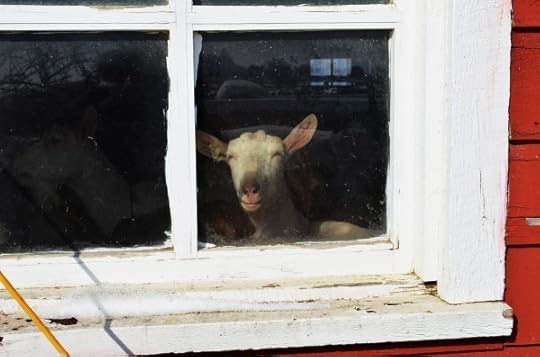



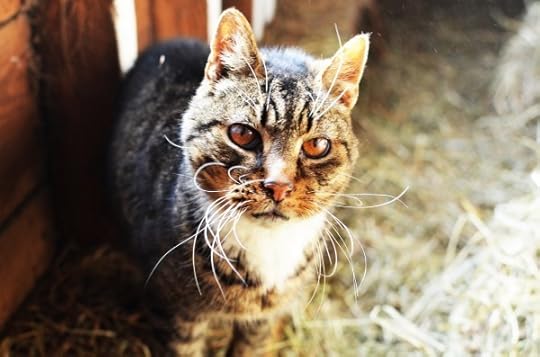














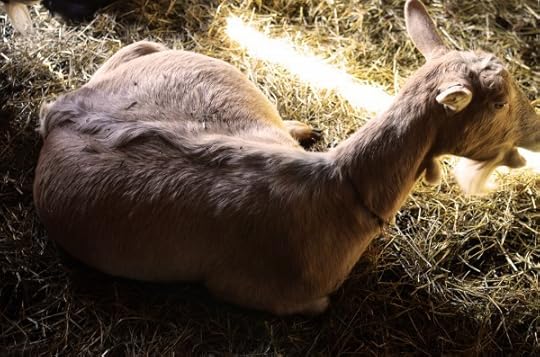

<
>
February 11, 2014
Sunday Breakfast, Sharon Springs-Style

You wanna know why people are so good and neighborly in Sharon Springs? It’s simple. Given the choice between spending Sunday mornings repenting in church or chowing down at the Stone House Farm’s pancake breakfast makes being virtuous an easy decision. Fresh maple syrup dripping down steaming, fluffy all-you-can-eat pancakes might be hell on your New Year’s diet, but it’s heaven on frozen February earth. (For those less-than-righteous neighbors who need a little church time, the pancake breakfast is served Saturday too.)
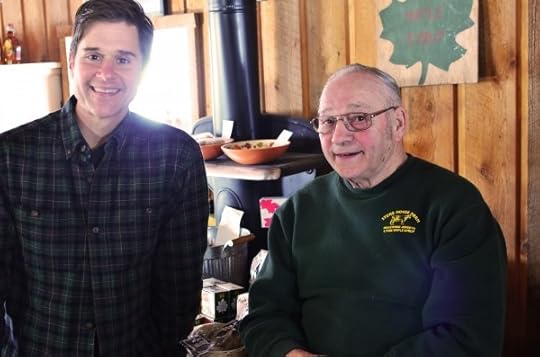
Stone House Farm is already nationally famous for their Jersey Girl cheese (which has been served everywhere from the U.S. Open to the White House.) But they’re locally beloved for their pancake breakfasts, served right in their maple syrup sap house. Thousands of folks drive, snowmobile and fly to Stone House Farm every season to chow down right next to the giant wood-fired evaporator that’s boiling down the sap for next weekend’s pancakes.
Yes, we said people “fly” in. As in: there are planes parked outside most weeks. Seriously. These planes aren’t decorative props. Check out the fresh landing gear tracks…
Oh, and like all great things in Sharon Springs…you can trace a direct line to Farmer John. Stone House Farm is owned and operated by John’s sister and brother-in-law, Patty and Tim Everett. And most weekends you’ll find John’s father Harold manning the door, along with a few other of John’s sisters, nieces & nephews helping out with the packed tables.
We’ll be honest…it’s tough for us to come up with many reasons to visit Sharon Springs during the coldest months of the year… but…this is the only time of year you can get a famous Stone House Farm breakfast. Cuz the pancake batter only pours while the sap is running…and that’s only between February and April.
Check out more photos below and plan your trip now. We’ll tell Harold to give you a seat next to the evaporator. (It’s the warmest place in Sharon Springs.)




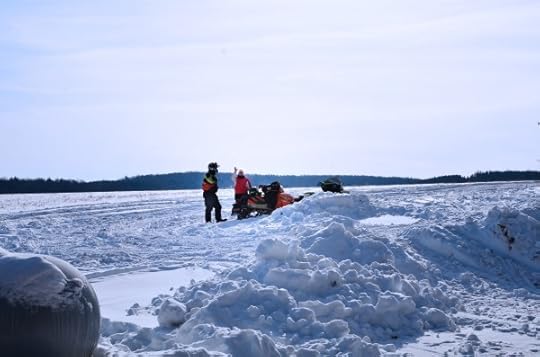

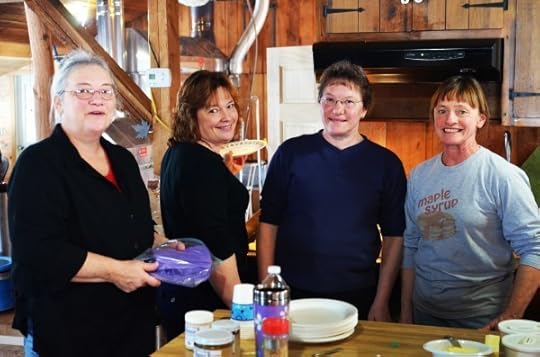

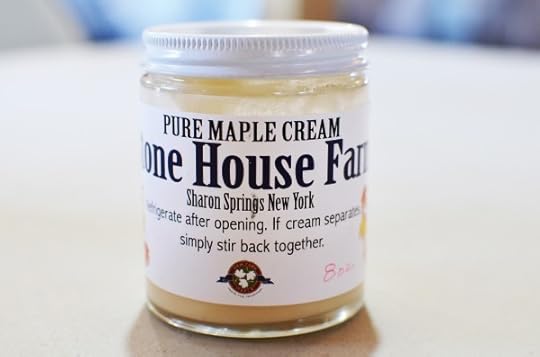
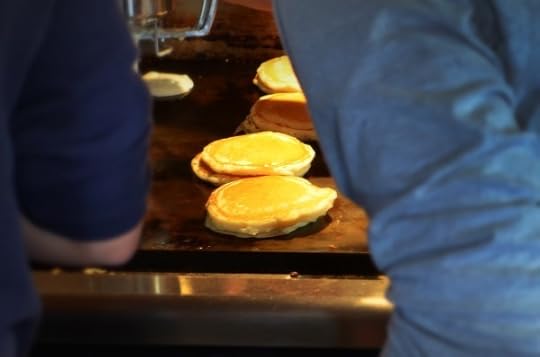
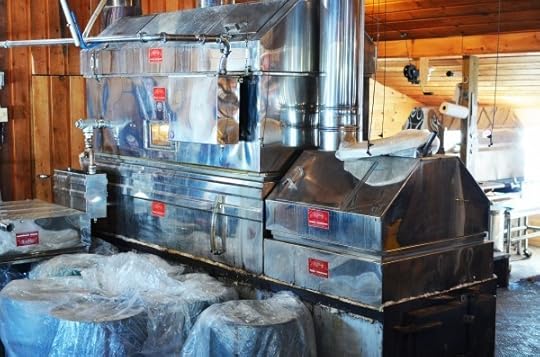


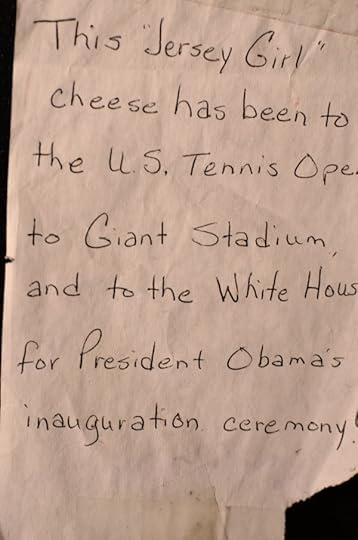

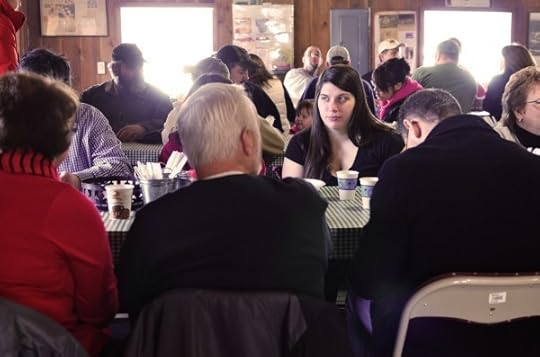
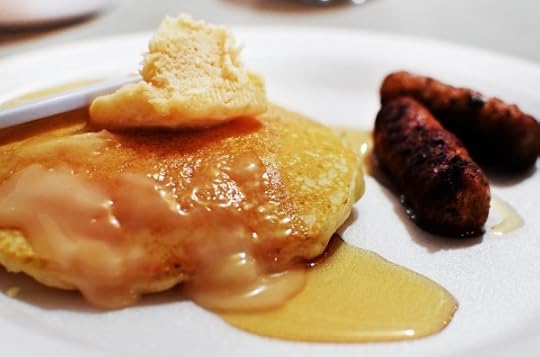





<
>
February 5, 2014
5 Beautiful Things
Heartbeats Accelerating
Of all the beautiful things in the world this week, I can think of nothing that surpasses the indescribable, joyous simplicity of love, which can be found in the most unassuming places if we are attuned to its presence. Seek and you shall find.
I Do Not Love You by Pablo Neruda
I do not love you as if you were salt-rose, or topaz,
Or the arrow of carnations the fire shoots off.
I love you as certain dark things are to be loved,
In secret, between the shadow and the soul.
I love you as the plant that never blooms
But carries in itself the light of hidden flowers;
Thanks to your love a certain solid fragrance,
Risen from the earth, lives darkly in my body.
I love you without knowing how, or when, or from where.
I love you straightforwardly, without complexities or pride;
So I love you because I know no other way than this:
Where ‘I’ does not exist, nor ‘you’,
So close that your hand on my chest is my hand,
So close that your eyes close as I fall asleep.
Five Beautiful Things
Heartbeats Accelerating
Of all the beautiful things in the world this week, I can think of nothing that surpasses the indescribable, joyous simplicity of love, which can be found in the most unassuming places if we are attuned to its presence. Seek and you shall find.
I Do Not Love You by Pablo Neruda
I do not love you as if you were salt-rose, or topaz,
Or the arrow of carnations the fire shoots off.
I love you as certain dark things are to be loved,
In secret, between the shadow and the soul.
I love you as the plant that never blooms
But carries in itself the light of hidden flowers;
Thanks to your love a certain solid fragrance,
Risen from the earth, lives darkly in my body.
I love you without knowing how, or when, or from where.
I love you straightforwardly, without complexities or pride;
So I love you because I know no other way than this:
Where ‘I’ does not exist, nor ‘you’,
So close that your hand on my chest is my hand,
So close that your eyes close as I fall asleep.
Handmade Seed Paper Valentine Tutorial
It’s hard to think of spring with all this frigid winter weather hanging around but how about you warm up someone’s heart this February with a handmade Valentine infused with thoughts of spring! Everything you need to make your own recycled seed paper Valentine is probably stashed somewhere in your kitchen as we speak. Have a paper shredder? Then you’re already halfway there! Turn that old paper back into paper pulp, mix in some wildflower seeds, and you’ve got plantable paper and a handmade gift for everyone in your address book. I promise you, it’s just that easy! Here’s what you’ll need:
Materials for Seed Paper:
Large bowl
Medium bowl
Hot water
Shredded paper
Slotted spoon
Paper mix-in’s (mica flakes, bits of twine, dried petals, etc) *Optional
Food coloring *Optional
Blender
Small seeds (lavender, coreopsis, coneflower, etc)
Glass measuring cup
Screen of some kind (I made mine from an embroidery hoop and tulle fabric)
Heart shaped cookie cutter
Dish towel
Materials for Cards:
Plain white cards and envelopes
Something to poke holes such as an awl
Cardstock
Printer
Seed paper planting instructions (click to open up a window to print from)
1/8″ ribbon
All purpose glue or tape runner
1. Place shredded (or torn) paper into a large bowl and fill with warm water. Let the paper sit in the bath for an hour or so or overnight. The longer the paper can sit in the bath the smoother the pulp will be.
2. Once the paper has soaked, scoop it out using a slotted spoon and place the paper into the blender. Fill the blender with clean warm water.
3. Now is when the mix-in’s are added to the paper. For this project I used mica flakes specifically marketed for paper making but feel free to experiment with anything from scraps of fabric and cut up twine to dried flower petals and food coloring.
*A note on food coloring The food coloring has to sit and absorb into the paper pulp in order to hold a color. For this project I did not let it sit so the affect is just a slight pastel hint of color as opposed to a deep red.
4. Blend the paper shreds and mix-in’s until a smooth pulp forms. If the paper isn’t moving freely around the blender add more water.
5. Once the pulp is thoroughly pureed, pour it into a clean bowl and add more water if necessary to achieve a smooth broth consistency.
6. Next, prepare the drain screen. Paper making screens can be purchased or use a window screen, flat kitchen strainer, or as I did, make one yourself! Tulle fabric from my studio plus an old embroidery hoop equals the perfect DIY paper making screen. Place the screen on top of a bowl to catch the drained liquid from the paper pulp and place your cookie cutter on top of the screen.
7. Pour about 1/4 cup of pulp into the measuring cup and mix in some seeds.
8. Pour the pulp into the cookie cutter to a thickness of about 1/4″. If necessary, spread the pulp out with your finger and press down on it to help the water drain out. Remove the cookie cutter.
9. Flip the screen over onto a dish towel and press down with a second dish towel to squeeze out excess water. Remove the screen and repeat steps 7 through 9 to make as many seed paper hearts as you need.
*Keep in mind that the hearts will retain the texture of whatever they’re sitting on. My dish towels have a deep texture so after they sat for a few minutes I gently moved them to a work table with no texture.
10. Let the hearts sit overnight or if time is a factor then gently place a heart between two pieces of cotton muslin and iron until the heart is completely dry.
11. To make the cards center a dry seed paper heart in the center of the front flap and poke two holes using an awl.
12. Thread ribbon through the holes and tie into a neat bow. Next, cut out the planting instructions and glue or tape them into the inside of the card over the visible ribbon.
Now go and make somebody’s day with a handmade Valentine surprise in the mail that will get their spring juices flowing!
Enjoy!
Lucy Blaire has written for countless craft magazines including Sew News, Stitch, Simply Handmade, and ReadyMade; she has appeared
on PBS’s Sew It All TV; writes for her blog, East Camp Home; and runs her
Etsy shop, Lucy Blaire Handmade.
With what little time is left Lucy can be found living quietly in Catskill, NY with her husband Ben and baby Marian in their little house with the red tin roof.
A February Harvest…
When most of us think of harvesting, we envision fields of grain, or orchards of fruit, or rows of vegetables. We think of summer. And autumn. What we usually don’t think of is “February.”
But to farmers in upstate New York during the 19th and 20th centuries, January and February were sometimes their most lucrative months of the entire year. That’s because New York City used more ice per capita than any other city in the world – 300,000 tons in fact. (That’s a lot of Manhattans.) And much of that ice came from upstate farms and communities.
Each January & February, (weather permitting, of course,) every available frozen fresh water source became a revenue stream. (Pun very much intended.) Farm ponds. Lakes. You name it…people harvested the ice as it “grew.” During bad growing seasons, farmers could make as much or more from their ice harvest than they did from their autumn harvests. And if the seasons temperatures were particularly brutal, one could even reap two harvests from the same pond. Small consolation for a bad winter.
Harvested ice was stored year-round, covered in sawdust, lodged in specially built ice houses. Sometimes the ice was stored locally until sent by horse-drawn cart to the city. And sometimes it was sent by rail-car down to giant ice houses just outside NYC. It was used in the meat industry; for hotels and restaurants; and, before the advent of electric refrigeration, it was used in the iceboxes of private homes.
After a particularly cold winter and a hefty harvest stored ice was available year-round – especially if the summer was cool. But after an “open winter,” when temperatures didn’t drop far enough or long enough to create harvestable ice, there would be an “ice famine” the following summer. This could cripple certain food industries, and impact the Amercian economy as negatively as a poor crop growing season.
Recently we visited the Hanford Mills Museum in nearby East Meredith, NY. During warm months, Hanford Mills operates as a historic water & steam powered lumber mill/museum. It’s well worth visiting to witness the antique mill equipment in action. But they also open up one day each February to harvest the ice from their pond. Visitors can help with the harvest, and the ice is stored on site until the following July 4th when it’s used to make homemade ice cream. (Pencilling in our calendars now.)
Check out our slideshow of the days events…

